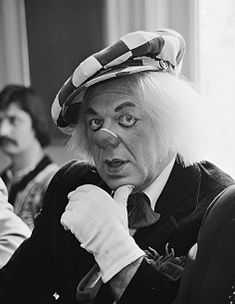Oleg Popov
| Oleg Popov | |
|---|---|
 Oleg Popov performing with the Russian State Circus, Worms, Germany, 28 March 2009 | |
| Born |
Oleg Konstantinovich Popov 31 July 1930 |
| Occupation | Clown and circus artist |

Oleg Konstantinovich Popov (Russian: Олег Константинович Попо́в, born 31 July 1930) is a famous Soviet and Russian clown and circus artist. Popov is also called the "Sunshine clown".
He was born on 31 July 1930 in Moscow, the son of a clock-maker. He studied elements of acrobatics, juggling, and other circus skills in his youth. In 1949, he graduated from the Russian circus school in Moscow and started his career in the Moscow Circus on Tsvetnoy Boulevard. Six years later, he became the first clown from the Union of Soviet Socialist Republics to perform in the Western world. In 1969, he was honored with the title of People's Artist of the USSR. Popov's fame extended to Melbourne, Australia, where he was named King of Moomba (1971).[1]
Career
Popov has performed as a clown, a mime, a tightrope walker, and a juggler. At the 8th International Circus Festival of Monte-Carlo in 1981, he won the "Oscar of the clown world": the Golden Clown award.[2] His role as a clown follows the tradition of the Russian "Ivanushka," who fools other people and who is teased himself.
Later he specialized in entertaining people as The Sunshine Clown, performing his art world wide and without any other circus requisite. His face painting is unique, and patented.
He was one of the most popular clowns in the Soviet Union during the second half of the 20th century. His idols include Charlie Chaplin and Heinz Rühmann, a German actor.
In 2006, Popov was invited to perform at the 30th anniversary of the International Circus Festival of Monte Carlo; at 75 years of age, he still managed to inspire a standing ovation.
References
| Wikimedia Commons has media related to Oleg Popov. |
- ↑ Craig Bellamy, Gordon Chisholm, Hilary Eriksen (17 February 2006) Moomba: A festival for the people. pp. 17–22
- ↑ "List of previous award winners". International Circus Festival of Monte-Carlo. Retrieved 13 January 2011.
External links
- Oleg Popov at the Internet Movie Database
- (Russian) Article about Popov in Argumenty i Fakty, 25 May 2006 Part I Part II.
|